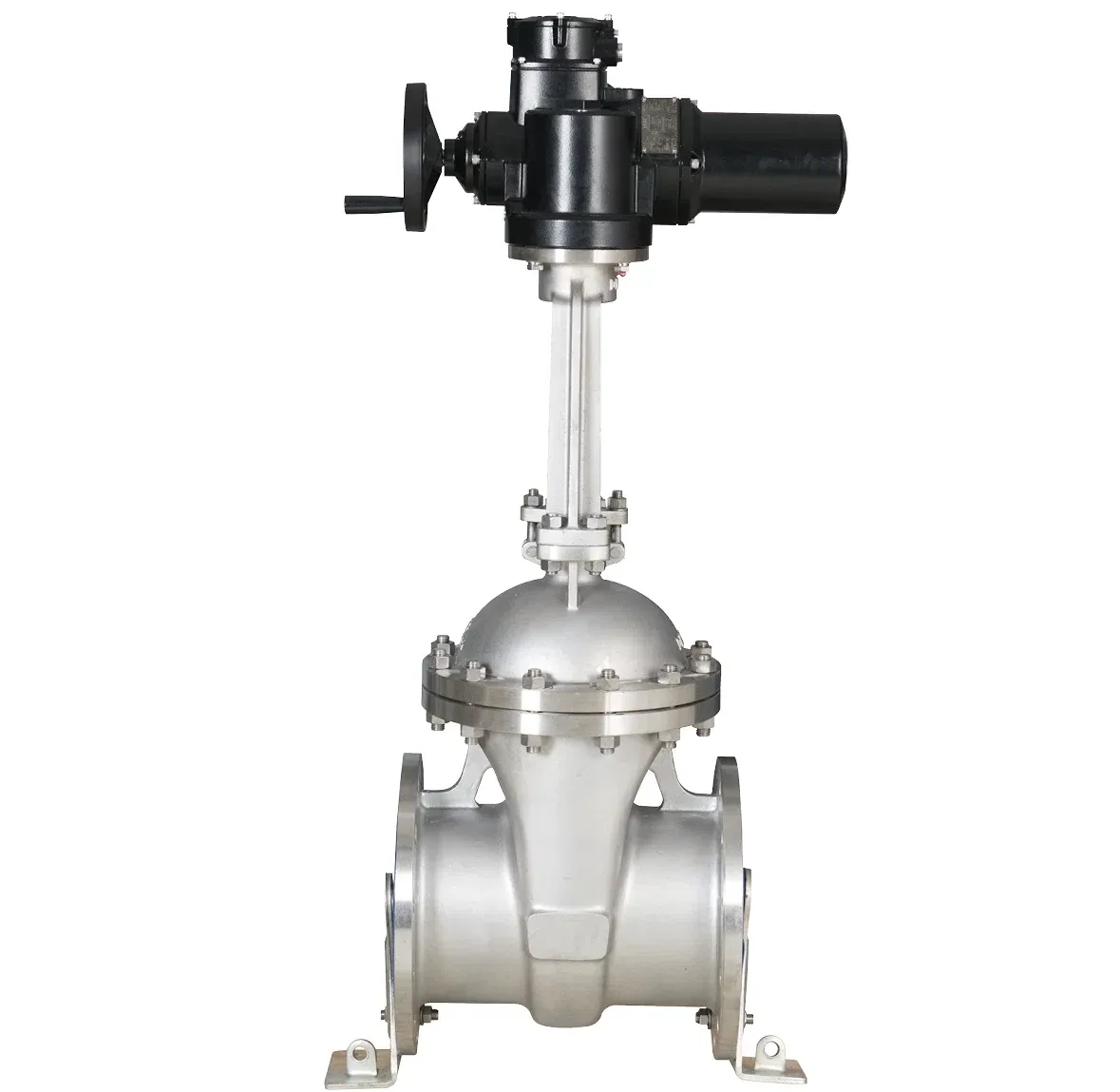
In the evolving landscape of industrial automation, motorized gate valves—also known as electric gate valves—have become indispensable for controlling fluid flow in pipelines. By integrating electric actuators, these valves allow precise linear movement of the gate to open or close, offering significant advantages over traditional manual gate valves. The implementation of motorized gate valves reduces labor costs, improves production efficiency, enhances safety, and enables seamless integration into automated systems, making them a vital component across a wide range of industries.
Unlike other valve types primarily designed for throttling or regulating flow, electric gate valves are chiefly used as cutoff valves. Their primary role is to connect or isolate a medium within a pipeline, ensuring secure and reliable operation in various conditions. Electric gate valves are especially suitable for medium to large diameter pipelines and can accommodate a broad spectrum of pressures, temperatures, and mediums.
The versatility of motorized gate valves is evident in their applications. They are widely employed in industries such as power generation, shipbuilding, pulp and paper processing, wastewater treatment, chemical plants, and oil and gas pipelines. The ability to handle water, oil, cement, paper pulp, and other mediums makes them an adaptable solution for diverse industrial scenarios.

A motorized gate valve consists of several essential components that work together to ensure reliable and precise operation. Understanding these components is crucial for appreciating the valve’s functionality and potential benefits:
The valve body is the primary structure that houses the internal components. It is designed to withstand high pressures and provide durability against the operating environment, whether that involves corrosive media, high temperatures, or abrasive fluids. Valve bodies are typically made of high-strength materials such as stainless steel, carbon steel, or ductile iron, depending on the application requirements.
The gate disc is the sliding element responsible for controlling flow within the pipeline. When the valve is opened, the disc moves upward, allowing the medium to pass. Conversely, when the valve is closed, the disc moves downward to block the flow completely. The design of the gate disc, whether solid, flexible, or wedge-shaped, determines the valve’s sealing efficiency and operational reliability.
The stem is the rod connecting the gate disc to the actuator. In a motorized gate valve, the stem transmits the rotational or linear force from the actuator to the gate disc, ensuring accurate positioning. Stems are typically made of corrosion-resistant steel or stainless steel to withstand repeated movement and exposure to various mediums.
The actuator is the heart of the motorized gate valve. It converts electrical energy into mechanical force, driving the movement of the gate disc. Electric actuators can be designed for various voltage inputs and offer precise control, making them ideal for automated systems.
Some motorized gate valves incorporate a gearbox to increase torque while reducing motor speed. This feature is particularly beneficial for larger valves where greater force is needed to operate the gate disc without requiring an oversized actuator.
Limit switches provide feedback on the valve’s position, confirming whether it is fully open or closed. These switches enhance operational accuracy and prevent over-travel, which could damage the valve or pipeline.
The position indicator offers visual confirmation of the gate’s position. This is especially useful in maintenance and monitoring, allowing operators to quickly verify valve status without accessing the control system.
Motorized gate valves offer numerous advantages compared to their manual counterparts, making them a preferred choice in modern industrial systems:
Electric actuators enable the valve to be operated remotely, eliminating the need for manual intervention. This capability is invaluable in hazardous or hard-to-access environments, reducing the risk to personnel while enhancing operational efficiency.
Motorized gate valves can be seamlessly integrated into automated process control systems. By interfacing with SCADA, DCS, or PLC systems, they can respond to programmed commands, maintain precise flow control, and adapt to real-time operational conditions.
Reducing manual handling in dangerous or high-pressure scenarios significantly enhances safety. Operators can control the valve from a secure location, avoiding direct exposure to hazardous mediums or extreme operating conditions.
Electric actuators provide accurate and repeatable valve positioning, ensuring consistent performance across cycles. This precision is particularly important in processes that require strict flow regulation, preventing wastage or operational inefficiencies.
Motorized gate valves operate faster than manual valves, especially for larger sizes where manual handling may be cumbersome. The actuator delivers the required torque with minimal delay, reducing downtime and enhancing productivity.
Motorized gate valves are designed to perform several core functions that contribute to their widespread adoption:
The primary function of an electric gate valve is fluid control. When the motor is energized, it drives the gate disc via the actuator and stem, either opening or closing the valve. This action allows precise management of fluid flow, ensuring pipelines are either fully operational or securely isolated. Gate valves are ideal for services requiring tight shutoff, such as water, oil, and chemical pipelines.
Automation is a key advantage of motorized gate valves. Through the use of limit switches and electric actuators, the valve can achieve automated opening and closing, reducing manual labor and increasing operational efficiency. Automated operation also enables faster response times to process changes, supporting industrial processes that demand high reliability and precision.
By integrating with control systems, motorized gate valves can be monitored and operated remotely. Operators in a centralized control room can check valve positions, initiate operations, and respond to emergencies without physical intervention. This capability enhances operational convenience, reduces the risk of accidents, and improves overall system responsiveness.
Motorized gate valves are built to withstand harsh industrial environments. They are usually fabricated from high-strength, corrosion-resistant materials capable of handling high pressures, extreme temperatures, and chemically aggressive fluids. Their robust construction ensures long service life even under frequent cycling, making them a reliable investment for critical infrastructure.
The adaptability of motorized gate valves makes them suitable for numerous industries:
Power Plants: Motorized gate valves are used in cooling systems, steam pipelines, and fuel supply lines, where precise control and remote operation are essential.
Water and Wastewater Treatment: These valves control water flow, sewage, and treatment chemicals in municipal and industrial facilities, enhancing safety and operational efficiency.
Oil and Gas: In pipelines, refineries, and storage facilities, motorized gate valves provide reliable isolation of crude oil, petroleum products, and other hydrocarbons.
Pulp and Paper Industry: Handling viscous mediums like pulp requires durable valves capable of full open or shut-off operations. Electric gate valves meet these demands effectively.
Shipbuilding and Marine Applications: In ship systems, motorized gate valves control ballast water, fuel lines, and cooling systems, providing safe and remote operation under challenging conditions.
Cement and Chemical Plants: These valves manage abrasive slurries, chemicals, and powders, ensuring reliable cutoff in demanding environments.
When selecting a motorized gate valve, several technical factors must be considered to ensure optimal performance:
Material selection depends on the operating medium, temperature, and pressure. Common materials include stainless steel, carbon steel, cast iron, and alloy steels. Corrosion resistance, wear resistance, and mechanical strength are critical considerations.
The actuator must deliver adequate torque to operate the valve under all expected conditions. Electrical specifications, duty cycle, and compatibility with control systems are key factors in actuator selection.
Motorized gate valves are available in a wide range of sizes and pressure ratings. Proper sizing ensures efficient operation and prevents unnecessary stress on the valve components.
Depending on the installation site, actuators and control systems may require protection against dust, water, and extreme temperatures. IP-rated enclosures or additional housings are commonly used to enhance durability.
Limit switches, position indicators, and feedback sensors ensure accurate operation and integration with automated systems. Reliable monitoring and control are essential for maintaining operational efficiency and safety.
With the continued shift toward Industry 4.0 and smart manufacturing, motorized gate valves are evolving to meet new demands:
Smart Actuators: Advanced actuators with IoT connectivity enable predictive maintenance, real-time monitoring, and analytics to prevent failures and reduce downtime.
Energy Efficiency: Electric actuators are being designed for lower power consumption without compromising performance, contributing to sustainable operations.
Enhanced Safety Features: New safety mechanisms, such as fail-safe actuators and remote emergency shutdown capabilities, are being integrated to further reduce operational risks.
Integration with Digital Twins: Motorized gate valves are increasingly part of digital twin models, allowing simulation, optimization, and remote diagnostics of complex industrial systems.
Motorized gate valves represent a critical advancement in fluid control technology. Their ability to provide remote operation, automated control, high durability, and precise flow management makes them an essential component across a wide spectrum of industries. From water treatment and power generation to pulp processing and marine applications, these valves enhance efficiency, safety, and reliability.
By investing in high-quality motorized gate valves, industries can ensure long-term operational stability, reduce maintenance costs, and achieve greater process automation. As industrial systems continue to evolve toward smarter, more connected operations, electric gate valves will remain at the forefront of innovation, delivering reliable performance in the most demanding environments.
As a leading motorized gate valve manufacturer in China, our commitment lies in producing high-performance, durable, and technologically advanced electric gate valves that meet international standards and support industrial automation worldwide.